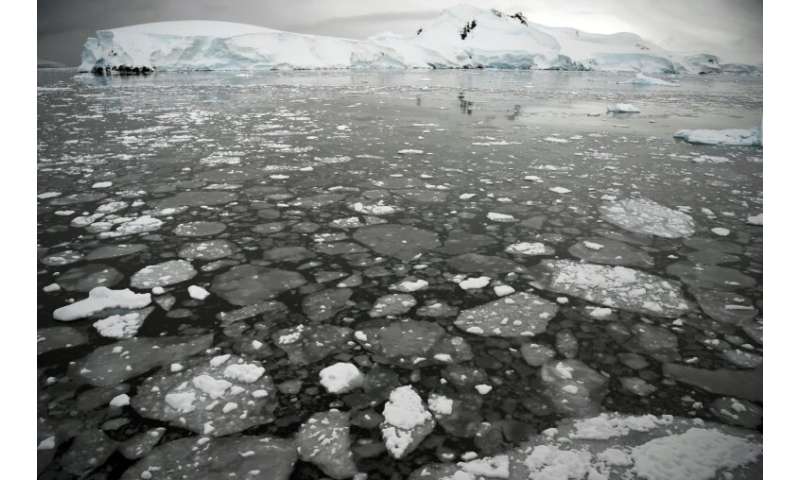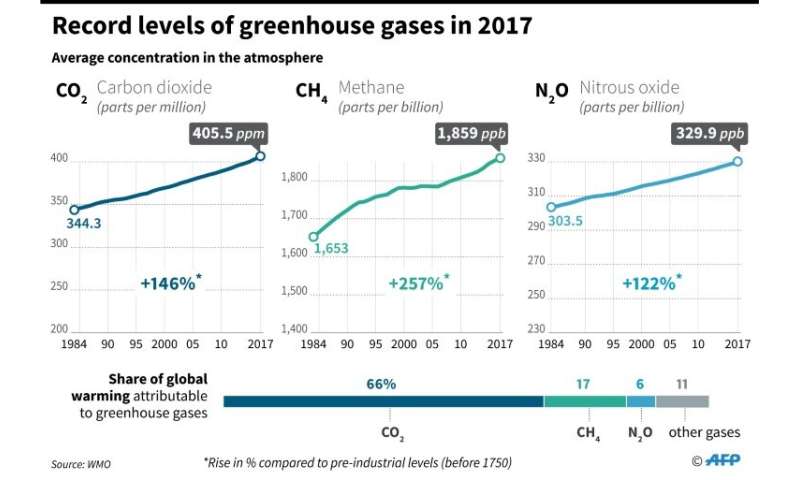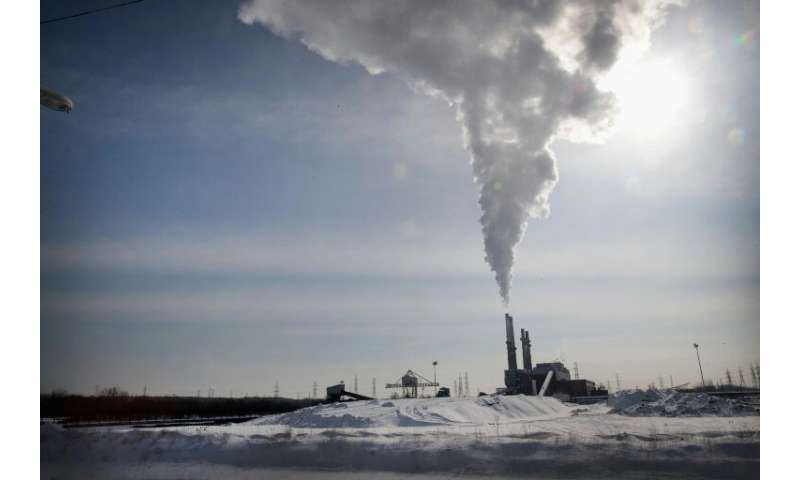Dire future etched in the past: CO2 at 3-million year-old levels. Patrick Galey and Marlowe Hood, Phys.org. Apr. 5, 2019.
 The last time there was so much CO2 in Earth's atmosphere, ice caps virtually disappeared
The last time there was so much CO2 in Earth's atmosphere, ice caps virtually disappeared
Planet-warming carbon dioxide in Earth's atmosphere—at its highest level in three million years—is poised to lock in dramatic temperature and sea level rises over a timescale of centuries, scientists warned this week.
The last time that CO2 hit 400 parts per million (ppm) Greenland was ice free and trees grew at the edge of Antarctica.
It was long thought that today's greenhouse gas levels were no greater than those 800,000 years ago, during a period of cyclical planetary warming and cooling that would have likely continued but for manmade emissions.
But analyses of ice cores and ocean sediments in the coldest place on Earth have now revealed that 400 ppm was last surpassed three million years ago during the Late Pliocene, when temperatures were several degrees Celsius higher, and oceans at least 15 metres deeper.
At the same time, state-of-the-art climate modelling by experts at the Potsdam Institute for Climate Impact Research (PIK) have correlated directly with the CO2 levels found in these Antarctic samples.
"The Late Pliocene is relatively close to us in terms of CO2 levels," Matteo Willeit, PIK member and lead study author, told AFP.
"Our models suggest that there were no glacial cycles—there were no big ice sheets in the northern hemisphere. CO2 was too high and the climate was too warm to allow big ice sheets to grow."
Nations in 2015 struck the landmark Paris deal on climate change, promising to curb greenhouse gas emissions and limit temperature rises to "well below" 2 Celsius (3.6 Fahrenheit).
Yet 2017 saw emissions levels unsurpassed in human history, and climate experts warn that time has all but run out to drastically slash fossil fuel use and avert runaway global warming.
Seas 15-20 metres higher
Scientists gathered this week in London for a conference on the Pliocene epoch, and highlighted the lessons to be learned today embedded in its ancient ice and sediment samples.
 Change in levels of CO2, methane and nitrous oxide in the atmosphere since 1984
Change in levels of CO2, methane and nitrous oxide in the atmosphere since 1984
"The headline news is that temperatures were 3-4 degrees higher globally than they are today, and sea levels were 15-20 metres (50-65 feet) higher," Martin Siegert, professor of geoscience at Imperial College London, told reporters.
With just 1C of warming so far, Earth is already dealing with floods, droughts and superstorms made worse by rising seas.
Siegert said that 400 ppm didn't mean that the severity of Pliocene sea-level rises was imminent. But unless humans figure a way to suck CO2 out of the air on a massive scale, severe impacts are inevitable, sooner or later.
"There's a lag," he explained. "If you turn on the oven at home and set it to 200C, it doesn't reach that (level) immediately. It's the same for climate."
Siegert said glaciologists, based on current CO2 concentrations, expect between 50 centimetres and one metre of sea-level rise this century.
"It would be difficult for it to be much more than that because it takes time to melt," he added.
"But it doesn't stop at 2100—it keeps going."
Rocketing pace of CO2
In October, the UN concluded that greenhouse gas emissions must decline by about half within 12 years to preserve a chance of capping global warming at 1.5C, the level needed to avoid severe climate impacts.
But despite these and earlier warnings, CO2 emissions from fossil fuel use, construction, aviation and agribusiness continue to rise, and are currently on track to heat up the planet 4C by century's end.
Even without additional carbon pollution, the outlook remains bleak.
 Manmade emissions on the other hand have added some 120 ppm of CO2 in a little over a century and a half
Manmade emissions on the other hand have added some 120 ppm of CO2 in a little over a century and a half
"If we stay at 400 ppm, we stay on the course to a Pliocene-like climate," said Tina van De Flierdt, a professor of isotope geochemistry at Imperial.
She warned that under similar conditions to the present day, the Pliocene saw the disappearance of the Greenland ice sheet—which today holds enough frozen water to raise sea levels by some seven metres worldwide.
"The West Antarctica ice sheet holds about 5 metres—that was probably gone," she added.
As is happening today, Earth's poles warmed far quicker than the rest of the planet during the Pliocene, earlier research has shown, including a study in Nature Climate Change.
During earlier periods, Earth has seen sustained concentrations of carbon dioxide was even higher than 400 ppm, but it took millions of years for those increases to occur.
Manmade greenhouse gas emissions, on the other hand, have boosted CO2 levels by more than 40 percent in a little over 150 years.
'A crazy experiment'
At 412 ppm and rising, experts said temperature rises of 3-4C are likely now locked in.
So what happened to Earth the last time CO2 was so prevalent?
It was captured in the trees, plants, animals and minerals alive at the time and buried underground when they died.
"And what we've been doing for the last 150 years is digging it all up and putting it back into the atmosphere," said Siegert.
"It's like a crazy experiment: 'Let's take that CO2 that took 100 million years to be sequestrated and put it back—instantly, on a geological timescale—in the atmosphere and see what happens'".
 The last time there was so much CO2 in Earth's atmosphere, ice caps virtually disappeared
The last time there was so much CO2 in Earth's atmosphere, ice caps virtually disappearedPlanet-warming carbon dioxide in Earth's atmosphere—at its highest level in three million years—is poised to lock in dramatic temperature and sea level rises over a timescale of centuries, scientists warned this week.
The last time that CO2 hit 400 parts per million (ppm) Greenland was ice free and trees grew at the edge of Antarctica.
It was long thought that today's greenhouse gas levels were no greater than those 800,000 years ago, during a period of cyclical planetary warming and cooling that would have likely continued but for manmade emissions.
But analyses of ice cores and ocean sediments in the coldest place on Earth have now revealed that 400 ppm was last surpassed three million years ago during the Late Pliocene, when temperatures were several degrees Celsius higher, and oceans at least 15 metres deeper.
At the same time, state-of-the-art climate modelling by experts at the Potsdam Institute for Climate Impact Research (PIK) have correlated directly with the CO2 levels found in these Antarctic samples.
"The Late Pliocene is relatively close to us in terms of CO2 levels," Matteo Willeit, PIK member and lead study author, told AFP.
"Our models suggest that there were no glacial cycles—there were no big ice sheets in the northern hemisphere. CO2 was too high and the climate was too warm to allow big ice sheets to grow."
Nations in 2015 struck the landmark Paris deal on climate change, promising to curb greenhouse gas emissions and limit temperature rises to "well below" 2 Celsius (3.6 Fahrenheit).
Yet 2017 saw emissions levels unsurpassed in human history, and climate experts warn that time has all but run out to drastically slash fossil fuel use and avert runaway global warming.
Seas 15-20 metres higher
Scientists gathered this week in London for a conference on the Pliocene epoch, and highlighted the lessons to be learned today embedded in its ancient ice and sediment samples.
 Change in levels of CO2, methane and nitrous oxide in the atmosphere since 1984
Change in levels of CO2, methane and nitrous oxide in the atmosphere since 1984"The headline news is that temperatures were 3-4 degrees higher globally than they are today, and sea levels were 15-20 metres (50-65 feet) higher," Martin Siegert, professor of geoscience at Imperial College London, told reporters.
With just 1C of warming so far, Earth is already dealing with floods, droughts and superstorms made worse by rising seas.
Siegert said that 400 ppm didn't mean that the severity of Pliocene sea-level rises was imminent. But unless humans figure a way to suck CO2 out of the air on a massive scale, severe impacts are inevitable, sooner or later.
"There's a lag," he explained. "If you turn on the oven at home and set it to 200C, it doesn't reach that (level) immediately. It's the same for climate."
Siegert said glaciologists, based on current CO2 concentrations, expect between 50 centimetres and one metre of sea-level rise this century.
"It would be difficult for it to be much more than that because it takes time to melt," he added.
"But it doesn't stop at 2100—it keeps going."
Rocketing pace of CO2
In October, the UN concluded that greenhouse gas emissions must decline by about half within 12 years to preserve a chance of capping global warming at 1.5C, the level needed to avoid severe climate impacts.
But despite these and earlier warnings, CO2 emissions from fossil fuel use, construction, aviation and agribusiness continue to rise, and are currently on track to heat up the planet 4C by century's end.
Even without additional carbon pollution, the outlook remains bleak.
 Manmade emissions on the other hand have added some 120 ppm of CO2 in a little over a century and a half
Manmade emissions on the other hand have added some 120 ppm of CO2 in a little over a century and a half"If we stay at 400 ppm, we stay on the course to a Pliocene-like climate," said Tina van De Flierdt, a professor of isotope geochemistry at Imperial.
She warned that under similar conditions to the present day, the Pliocene saw the disappearance of the Greenland ice sheet—which today holds enough frozen water to raise sea levels by some seven metres worldwide.
"The West Antarctica ice sheet holds about 5 metres—that was probably gone," she added.
As is happening today, Earth's poles warmed far quicker than the rest of the planet during the Pliocene, earlier research has shown, including a study in Nature Climate Change.
During earlier periods, Earth has seen sustained concentrations of carbon dioxide was even higher than 400 ppm, but it took millions of years for those increases to occur.
Manmade greenhouse gas emissions, on the other hand, have boosted CO2 levels by more than 40 percent in a little over 150 years.
'A crazy experiment'
At 412 ppm and rising, experts said temperature rises of 3-4C are likely now locked in.
So what happened to Earth the last time CO2 was so prevalent?
It was captured in the trees, plants, animals and minerals alive at the time and buried underground when they died.
"And what we've been doing for the last 150 years is digging it all up and putting it back into the atmosphere," said Siegert.
"It's like a crazy experiment: 'Let's take that CO2 that took 100 million years to be sequestrated and put it back—instantly, on a geological timescale—in the atmosphere and see what happens'".
No comments:
Post a Comment